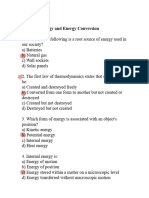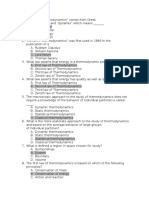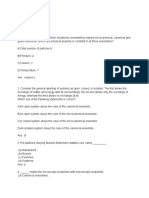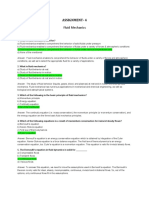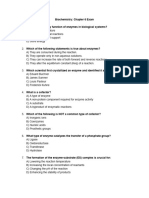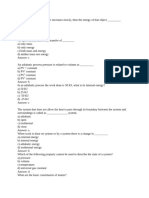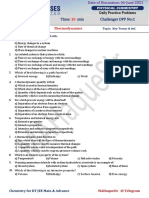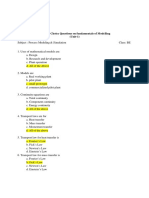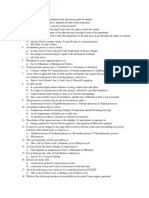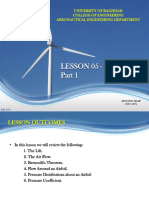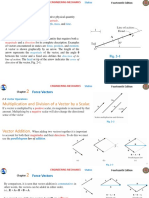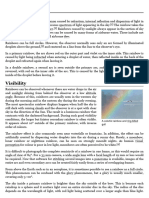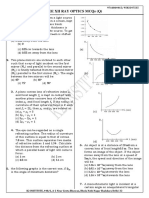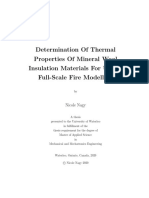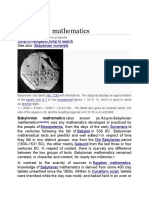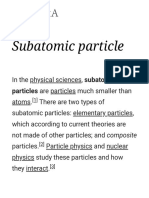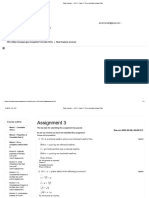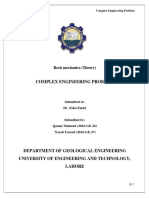0 ratings0% found this document useful (0 votes)
9 viewsSheet 1
Sheet 1
Uploaded by
Dheyaa Al-JubouriThis document contains a multiple choice quiz on thermodynamics concepts with 44 questions and their solutions. The questions cover topics such as the definitions and origins of terms in thermodynamics, the laws of thermodynamics, properties of systems, equilibrium states, quasi-static processes, and descriptions of steady, uniform, and transient processes. The document is intended to test understanding of fundamental thermodynamics concepts.
Copyright:
© All Rights Reserved
Available Formats
Download as PDF, TXT or read online from Scribd
Sheet 1
Sheet 1
Uploaded by
Dheyaa Al-Jubouri0 ratings0% found this document useful (0 votes)
9 views14 pagesThis document contains a multiple choice quiz on thermodynamics concepts with 44 questions and their solutions. The questions cover topics such as the definitions and origins of terms in thermodynamics, the laws of thermodynamics, properties of systems, equilibrium states, quasi-static processes, and descriptions of steady, uniform, and transient processes. The document is intended to test understanding of fundamental thermodynamics concepts.
Original Title
sheet 1
Copyright
© © All Rights Reserved
Available Formats
PDF, TXT or read online from Scribd
Share this document
Did you find this document useful?
Is this content inappropriate?
This document contains a multiple choice quiz on thermodynamics concepts with 44 questions and their solutions. The questions cover topics such as the definitions and origins of terms in thermodynamics, the laws of thermodynamics, properties of systems, equilibrium states, quasi-static processes, and descriptions of steady, uniform, and transient processes. The document is intended to test understanding of fundamental thermodynamics concepts.
Copyright:
© All Rights Reserved
Available Formats
Download as PDF, TXT or read online from Scribd
Download as pdf or txt
0 ratings0% found this document useful (0 votes)
9 views14 pagesSheet 1
Sheet 1
Uploaded by
Dheyaa Al-JubouriThis document contains a multiple choice quiz on thermodynamics concepts with 44 questions and their solutions. The questions cover topics such as the definitions and origins of terms in thermodynamics, the laws of thermodynamics, properties of systems, equilibrium states, quasi-static processes, and descriptions of steady, uniform, and transient processes. The document is intended to test understanding of fundamental thermodynamics concepts.
Copyright:
© All Rights Reserved
Available Formats
Download as PDF, TXT or read online from Scribd
Download as pdf or txt
You are on page 1of 14
Sheet One
Q. Multiple-choice questions (MCQ) with solutions
1 .What is the name origin of the term "thermodynamics?"
a) Greek words therme and dynamis
b) Greek words heat and power
c) Latin words thermus and dynamis
d) Latin words heat and power
Solution: b) Greek words therme (heat) and dynamis (power).
2 .Which law of thermodynamics is an expression of the conservation of
energy principle?
a) First law of thermodynamics
b) Second law of thermodynamics
c) Law of heat addition
d) Law of pressure-volume work
Solution: a) First law of thermodynamics.
3 .What does the second law of thermodynamics state about energy?
a) Energy can be created and destroyed.
b) Energy can only be converted from one form to another.
c) Energy has quality as well as quantity.
d) Energy is conserved in all processes.
Solution: c) Energy has quality as well as quantity, and actual processes
occur in the direction of decreasing quality of energy.
4 .What is the measure of the disorder or randomness of a system?
a) Energy balance
b) Entropy
c) Conservation of energy
d) Heat addition
Lect.Dr. Hiba Mudhafar Hashim
Solution: b) Entropy.
5 .Which property does classical thermodynamics primarily focus on?
a) Behavior of individual particles
b) Energy conversion
c) Bulk properties of matter
d) Entropy
Solution: c) Bulk properties of matter, such as temperature, pressure, and
volume.
6 .What is the definition of a system?
a) The region outside the system
b) The surroundings of the system
c) A fixed mass or a region in space chosen for study
d) The boundary that separates the system from its surroundings
Solution: c) A fixed mass or a region in space chosen for study.
7 .What is the role of the boundary in a system?
a) It separates the system from the surroundings
b) It defines the region outside the system
c) It controls the mass flow in the system
d) It encloses devices such as compressors and turbines
Solution: a) It separates the system from the surroundings.
8 .What is a closed system also known as?
a) Control mass
b) Control volume
c) Isolated system
d) Open system
Solution: a) Control mass.
9 .In a closed system, can mass cross its boundary?
a) Yes
b) No
Lect.Dr. Hiba Mudhafar Hashim
Solution: b) No.
10. What can cross the boundary of a closed system?
a) Mass and energy
b) Mass only
c) Energy only
d) Neither mass nor energy
Solution: c) Energy only.
11 .Which of the following is an example of an intensive property?
a) Mass
b) Volume
c) Energy
d) Temperature
Solution: d) Temperature.
12 .How can you determine whether a property is intensive or extensive?
a) By dividing the system into two equal parts
b) By measuring the property's value
c) By comparing it to other properties
d) By analyzing its physical characteristics
Solution: a) By dividing the system into two equal parts.
13 .Which of the following is an example of an extensive property?
a) Density
b) Pressure
c) Color
d) Volume
Solution: d) Volume.
14 .What happens to an extensive property when the system is divided
into two equal parts?
a) The property remains the same as the original system.
Lect.Dr. Hiba Mudhafar Hashim
b) The property becomes half of the original system.
c) The property doubles compared to the original system.
d) The property changes unpredictably.
Solution: b) The property becomes half of the original system.
15 .Which of the following is an example of an intensive property?
a) Mass
b) Melting point
c) Energy
d) Momentum
Solution: b) Melting point.
16 .Which of the following defines the state of a system?
a) Equilibrium values
b) Unbalanced forces
c) Measurable or calculated properties
d) Changes in composition
Solution: c) Measurable or calculated properties.
17 .In an equilibrium state, what can be said about the properties of a
system?
a) They have unbalanced forces.
b) They are constantly changing.
c) They have reached constant values.
d) They are in a state of imbalance.
Solution: c) They have reached constant values.
18 .Which type of equilibrium state refers to the temperature being the
same throughout the system?
a) Thermal equilibrium
b) Mechanical equilibrium
c) Phase equilibrium
d) Chemical equilibrium
Lect.Dr. Hiba Mudhafar Hashim
Solution: a) Thermal equilibrium.
19 .What is the characteristic of a system in mechanical equilibrium?
a) Constant temperature
b) Constant pressure
c) Coexistence of multiple phases
d) Unchanging chemical composition
Solution: b) Constant pressure.
20 .Phase equilibrium refers to the coexistence of how many phases of
matter in equilibrium?
a) One
b) Two
c) Three
d) Four
Solution: b) Two.
21 .Which field of study deals with systems that are in equilibrium or
approaching equilibrium?
a) Chemistry
b) Physics
c) Thermodynamics
d) Mechanics
Solution: c) Thermodynamics.
22 .What can the laws of thermodynamics be used to predict?
a) Unbalanced forces
b) Changes in composition
c) Equilibrium behavior of systems
d) Constant values of properties
Solution: c) Equilibrium behavior of systems.
Lect.Dr. Hiba Mudhafar Hashim
23 .How do systems change from one equilibrium state to another?
a) By altering their properties
b) Through unbalanced forces
c) By undergoing chemical reactions
d) By following the laws of thermodynamics
Solution: d) By following the laws of thermodynamics.
24 .Which type of equilibrium state refers to the chemical composition of
the system not changing with time?
a) Thermal equilibrium
b) Mechanical equilibrium
c) Phase equilibrium
d) Chemical equilibrium
Solution: d) Chemical equilibrium.
25 .What does thermodynamics study the relationships between?
a) Temperature and pressure
b) Heat, work, and energy
c) Equilibrium and potential
d) Mass and volume
Solution: b) Heat, work, and energy.
26 .What causes a process in a system?
a) Equilibrium forces
b) Heat transfer only
c) Work done on the system only
d) Heat transfer and work done on the system
Solution: d) Heat transfer and work done on the system.
27 .What is a quasi-static process?
a) A process that occurs rapidly
b) A process that occurs infinitely slowly
c) A process with abrupt changes in properties
Lect.Dr. Hiba Mudhafar Hashim
d) A process with unbalanced forces
Solution: b) A process that occurs infinitely slowly.
28 .What is a key characteristic of a quasi-static process?
a) Abrupt changes in properties
b) Unbalanced forces within the system
c) Smooth and gradual changes in properties
d) Rapid equilibrium transitions
Solution: c) Smooth and gradual changes in properties.
29 .Are quasi-static processes achievable in practice?
a) Yes, they can be achieved easily.
b) Yes, with certain conditions.
c) No, they are idealized processes.
d) No, they require unbalanced forces.
Solution: c) No, they are idealized processes.
30 .What remains constant during an isothermal process?
a) Temperature
b) Pressure
c) Specific volume
d) Equilibrium forces
Solution: a) Temperature.
31 .What remains constant during an isobaric process?
a) Temperature
b) Pressure
c) Specific volume
d) Equilibrium forces
Solution: b) Pressure.
32 .What remains constant during an isochoric process?
a) Temperature
b) Pressure
Lect.Dr. Hiba Mudhafar Hashim
c) Specific volume
d) Equilibrium forces
Solution: c) Specific volume.
33 .What is it called when a system returns to its initial state at the end of
a process?
a) Equilibrium state
b) Quasi-static process
c) Isobaric process
d) Cycle
Solution: d) Cycle.
34 .What is the relationship between quasi-static processes and real
systems?
a) Quasi-static processes are achievable in real systems.
b) Quasi-static processes have abrupt changes in properties.
c) Quasi-static processes allow simplifying assumptions about real
systems.
d) Quasi-static processes require unbalanced forces in real systems.
Solution: c) Quasi-static processes allow simplifying assumptions about
real systems.
35 .What is the defining characteristic of a quasi-static process?
a) Infinitely rapid changes in properties
b) Gradual change in properties
c) Unbalanced forces within the system
d) Equilibrium transitions
Solution: b) Gradual change in properties.
36 .What does the term "steady" imply?
a) No change with location
b) No change with time
c) Gradual change with time
d) Gradual change with location
Lect.Dr. Hiba Mudhafar Hashim
Solution: b) No change with time.
37 .What is the opposite of "steady?"
a) Unsteady
b) Uniform
c) Transient
d) Gradual
Solution: a) Unsteady.
38 .What does the term "uniform" imply?
a) No change with time
b) No change with location
c) Gradual change with time
d) Gradual change with location
Solution: b) No change with location.
39 .What is the opposite of "uniform?"
a) Steady
b) Unsteady
c) Transient
d) Gradual
Solution: b) Unsteady.
40 .Which term describes a process with no change over a specified
region?
a) Steady
b) Unsteady
c) Uniform
d) Transient
Solution: c) Uniform.
41 .Which term describes a process with gradual change with time?
a) Steady
Lect.Dr. Hiba Mudhafar Hashim
b) Unsteady
c) Uniform
d) Transient
Solution: d) Transient.
42 .Which term describes a process with gradual change with location?
a) Steady
b) Unsteady
c) Uniform
d) Transient
Solution: d) Transient.
43 .What is the relationship between the terms "steady" and "unsteady?"
a) They are opposite in meaning.
b) They describe the same type of process.
c) They both imply no change with location.
d) They both imply no change with time.
Solution: a) They are opposite in meaning.
44 .What is the relationship between the terms "uniform" and "transient?"
a) They are opposite in meaning.
b) They describe the same type of process.
c) They both imply no change with location.
d) They both imply no change with time.
Solution: a) They are opposite in meaning.
45 .Which term describes a process with gradual change both with time
and location?
a) Steady
b) Unsteady
c) Uniform
d) Transient
Lect.Dr. Hiba Mudhafar Hashim
Solution: b) Unsteady.
46 .What happens when a body at a higher temperature is brought into
contact with a body at a lower temperature?
a) Heat is transferred from the body at lower temperature to the one at
higher temperature.
b) Heat is transferred from the body at higher temperature to the one at
lower temperature.
c) Both bodies attain the same temperature instantly.
d) Both bodies remain at their initial temperatures.
Solution: b) Heat is transferred from the body at higher temperature to the
one at lower temperature.
47 .What is the condition for two bodies to reach thermal equilibrium?
a) Equal mass
b) Equal volume
c) Equal pressure
d) Equal temperature
Solution: d) Equal temperature.
48 .What is the requirement for thermal equilibrium between two bodies?
a) Equal heat transfer
b) Equal mass transfer
c) Equal temperature reading
d) Equal pressure distribution
Solution: c) Equal temperature reading.
49 .What is the zeroth law of thermodynamics?
a) Heat cannot be created or destroyed.
b) Energy flows from high temperature to low temperature.
c) The temperature of a system tends to decrease over time.
d) Bodies in thermal equilibrium have the same temperature.
Solution: d) Bodies in thermal equilibrium have the same temperature.
Lect.Dr. Hiba Mudhafar Hashim
50 .How can the zeroth law of thermodynamics be restated?
a) Bodies at different temperatures are in thermal equilibrium.
b) Bodies at the same temperature are not in thermal equilibrium.
c) Bodies in thermal equilibrium have different temperature readings.
d) Bodies in thermal equilibrium have the same temperature reading.
Solution: d) Bodies in thermal equilibrium have the same temperature
reading.
51 .What does the zeroth law of thermodynamics state about bodies in
thermal equilibrium?
a) They have equal mass.
b) They have equal volume.
c) They have equal pressure.
d) They have the same temperature even if not in contact.
Solution: d) They have the same temperature even if not in contact.
52 .What is the significance of the zeroth law of thermodynamics?
a) It defines the direction of heat transfer.
b) It establishes the concept of thermal equilibrium.
c) It explains the behavior of bodies at different temperatures.
d) It determines the rate of temperature change in a system.
Solution: b) It establishes the concept of thermal equilibrium.
53 .What is the relationship between the zeroth law of thermodynamics
and bodies in thermal equilibrium?
a) Bodies in thermal equilibrium have the same temperature.
b) Bodies in thermal equilibrium have different temperature readings.
c) Bodies in thermal equilibrium have different mass.
d) Bodies in thermal equilibrium have different pressure.
Solution: a) Bodies in thermal equilibrium have the same temperature.
54 .What does the zeroth law of thermodynamics imply about bodies in
thermal equilibrium?
a) They have different temperature readings.
Lect.Dr. Hiba Mudhafar Hashim
b) They have different heat capacities.
c) They have different thermal conductivity.
d) They have the same temperature as a third body.
Solution: d) They have the same temperature as a third body.
55 .What is the only requirement for bodies to be in thermal equilibrium?
a) Equal heat transfer
b) Equal mass transfer
c) Equal temperature
d) Equal pressure
Solution: c) Equal temperature.
Q. True or False questions with solutions
1 .Dimensions are directly measurable properties of a physical quantity.
Solution: False. Dimensions are not directly measurable.
2 .The fundamental dimensions in physics include mass, length, time, and
temperature.
Solution: True.
3 .Units are assigned to dimensions to give them a numerical value.
Solution: True.
4 .The SI units for the fundamental dimensions are kilogram, meter,
second, and kelvin.
Solution: True.
5 .Derived dimensions are dimensions that cannot be expressed in terms
of fundamental dimensions.
Solution: False. Derived dimensions can be expressed in terms of
fundamental dimensions.
6 .The dimensions of a physical quantity are dependent on its units.
Solution: False. The dimensions of a physical quantity are independent of
its units.
Lect.Dr. Hiba Mudhafar Hashim
7 .The units of a physical quantity can only be changed by multiplying or
dividing by a conversion factor.
Solution: True.
8 .The dimensions of a physical quantity must be consistent with the
equation that defines it.
Solution: True.
9 .Intensive properties depend on the size or extent of a system.
Solution: False. Intensive properties do not depend on the size or extent
of a system.
10 .Temperature is an example of an intensive property.
Solution: True.
11 .Extensive properties depend on the size or extent of a system.
Solution: True.
12 .The mass of a system is an example of an intensive property.
Solution: False. The mass of a system is an extensive property.
13 .Dividing a system into two equal parts helps determine whether a
property is intensive or extensive.
Solution: True.
14 .If the property of each part is half the property of the original system,
then the property is intensive.
Solution: False. If the property of each part is the same as the property of
the original system, then the property is intensive.
15 .Density is an example of an extensive property.
Solution: False. Density is an intensive property.
16 .Energy is an example of an extensive property.
Solution: True.
Lect.Dr. Hiba Mudhafar Hashim
You might also like
- GB18045 2000 (E)Document15 pagesGB18045 2000 (E)Mehdi MosayebiNo ratings yet
- P.P MCQ 1&2 PDFDocument4 pagesP.P MCQ 1&2 PDFAhan Bhaskar100% (2)
- Thermodynamics Mock Exam PDFDocument29 pagesThermodynamics Mock Exam PDFChristopher Allen VarsoviaNo ratings yet
- Chapter 10Document21 pagesChapter 10kent russel lauriquezNo ratings yet
- ThermodynamicsDocument7 pagesThermodynamicsMath and Science ClassesNo ratings yet
- CH 1 MCQ Questions - StudentsDocument12 pagesCH 1 MCQ Questions - Students胡俊賓No ratings yet
- MCQ in Thermodynamics 000ANSDocument33 pagesMCQ in Thermodynamics 000ANSjenny92% (13)
- All Mcqs 2020 ChemDocument631 pagesAll Mcqs 2020 ChemContact AmsibNo ratings yet
- Heat 200 McqsDocument41 pagesHeat 200 McqsParshantKumarBajaj100% (2)
- Thermodynamics MCQDocument83 pagesThermodynamics MCQChristian RoxasNo ratings yet
- MCQ in Thermodynamics 000ANSDocument33 pagesMCQ in Thermodynamics 000ANSSANKAR VNo ratings yet
- 1000 Engineering Thermodynamics MCQ (Multiple Choice Questions)Document21 pages1000 Engineering Thermodynamics MCQ (Multiple Choice Questions)DJ IBileNo ratings yet
- Solution ThermodynamicsDocument15 pagesSolution ThermodynamicsADRIAN TOMAS BERNANDINONo ratings yet
- Exam ThermoDocument8 pagesExam ThermoJojimar JulianNo ratings yet
- Document 3Document36 pagesDocument 3kienaberekaladatNo ratings yet
- ThermodynamicsDocument34 pagesThermodynamicsJohn Cabrera PlacenteNo ratings yet
- Assignment 1Document8 pagesAssignment 1Oy BenjieNo ratings yet
- ThermodynamicsDocument127 pagesThermodynamicsJonathan Quilang ObienaNo ratings yet
- ديناميكا حراريةDocument41 pagesديناميكا حراريةmaryam24902No ratings yet
- PSPH301 QP Website Statastical MechanicsDocument9 pagesPSPH301 QP Website Statastical MechanicsLol Blah100% (1)
- Guide 2nd PeriodDocument11 pagesGuide 2nd PeriodrdNo ratings yet
- The Concept of Exergy Was Introduced byDocument39 pagesThe Concept of Exergy Was Introduced bymebrahtuNo ratings yet
- ASSIGNDocument7 pagesASSIGNAngelika ThomasNo ratings yet
- Question Paper Applied Physics, Sem-1, BS-105Document5 pagesQuestion Paper Applied Physics, Sem-1, BS-105Kartik AgrawalNo ratings yet
- PHY 206 Thermal Physics Multiple Choice QuestionsDocument55 pagesPHY 206 Thermal Physics Multiple Choice QuestionsOlamide Ajasa0% (1)
- Physics TheoryDocument5 pagesPhysics Theorya22229No ratings yet
- Biochemistry - Chapter 6 ExamDocument18 pagesBiochemistry - Chapter 6 ExamViktorNo ratings yet
- Chemical Energetics 2Document14 pagesChemical Energetics 2Shafqat ShakeelNo ratings yet
- (MCQs) بنك1 focuses on Plant Equipment PlanningDocument12 pages(MCQs) بنك1 focuses on Plant Equipment Planningiahmedazez7No ratings yet
- Xi Worksheet 3-10-23 - 11102023 - 104010Document5 pagesXi Worksheet 3-10-23 - 11102023 - 104010Adithya PramodNo ratings yet
- Physics SS1Document4 pagesPhysics SS1obgfactorNo ratings yet
- PHY 121 Questions and AnswersDocument4 pagesPHY 121 Questions and AnswersahmadmuawiyadanbabaNo ratings yet
- Mathematics MCQsDocument4 pagesMathematics MCQs66gfaisalNo ratings yet
- Chem 103 (Vincent Korboi)Document7 pagesChem 103 (Vincent Korboi)villedelron7No ratings yet
- Chapter 1Document6 pagesChapter 1anil thakurNo ratings yet
- Thermodynamic MCQDocument17 pagesThermodynamic MCQsan creatorNo ratings yet
- Question and AnswerDocument9 pagesQuestion and Answer마비 니제시카No ratings yet
- Top Q - Thermodynamics - IDocument5 pagesTop Q - Thermodynamics - IshreyanajreNo ratings yet
- Long Quiz in Therodynamics 2023Document6 pagesLong Quiz in Therodynamics 2023jeffersonmanalo787No ratings yet
- DPP 1 ThermoDocument1 pageDPP 1 ThermoBhushanNo ratings yet
- Part 3 Physical ScienceDocument4 pagesPart 3 Physical ScienceRonald A. CarniceNo ratings yet
- CHM 231 Summer Tutorial Questions 2022Document10 pagesCHM 231 Summer Tutorial Questions 2022hhude65No ratings yet
- Online Test On Chemical Thermodynamics and Energetic PDFDocument3 pagesOnline Test On Chemical Thermodynamics and Energetic PDFrvignesh2809No ratings yet
- Mine Design QB2024 FDocument29 pagesMine Design QB2024 FMohamed GamalNo ratings yet
- Thermodynamics - EXIT EXAM TutorialDocument18 pagesThermodynamics - EXIT EXAM TutorialKiraNo ratings yet
- Model ExamDocument17 pagesModel Exammengstuhagos1223No ratings yet
- Time: 3 Hrs (Regulation 2013) Maximum: 100 Marks Answer All QuestionsDocument7 pagesTime: 3 Hrs (Regulation 2013) Maximum: 100 Marks Answer All QuestionsKARTHINo ratings yet
- Multiple Choice Questions On Fundamentals of Modelling (Unit-1)Document24 pagesMultiple Choice Questions On Fundamentals of Modelling (Unit-1)Pratik Kedare100% (1)
- 26 Important MCQS: Unit - V (Drug Stability)Document28 pages26 Important MCQS: Unit - V (Drug Stability)Vikash KushwahaNo ratings yet
- Industrial/Power Plant Engineering: Prepared By: Engr. Jose R. FranciscoDocument6 pagesIndustrial/Power Plant Engineering: Prepared By: Engr. Jose R. FranciscoJerick HernandezNo ratings yet
- Interview Questions (TD)Document9 pagesInterview Questions (TD)anil gautamNo ratings yet
- UET Lahore Entry Test Sample PaperDocument17 pagesUET Lahore Entry Test Sample PaperShawn Parker86% (14)
- 1st QuizDocument4 pages1st QuizhirraanjumNo ratings yet
- Rev CheCalcDocument4 pagesRev CheCalcche.2ndyearNo ratings yet
- KMUCAT (2023) Paper IDocument11 pagesKMUCAT (2023) Paper Imuhammadalirana1056No ratings yet
- MCQ AtdDocument69 pagesMCQ Atddaponnaswami07gmailcNo ratings yet
- CFD Mid1 ExamDocument12 pagesCFD Mid1 ExamJoshua SimonNo ratings yet
- lecture5 2Document12 pageslecture5 2Dheyaa Al-JubouriNo ratings yet
- lab-chapter 2Document4 pageslab-chapter 2Dheyaa Al-JubouriNo ratings yet
- Lecture 6Document7 pagesLecture 6Dheyaa Al-JubouriNo ratings yet
- ENGR251 F 2011 Q1 X SolDocument4 pagesENGR251 F 2011 Q1 X SolDheyaa Al-JubouriNo ratings yet
- 05 The Lift - Part 1Document24 pages05 The Lift - Part 1Dheyaa Al-JubouriNo ratings yet
- المحاضره الخامسهDocument11 pagesالمحاضره الخامسهDheyaa Al-JubouriNo ratings yet
- المحاضره الثالثهDocument6 pagesالمحاضره الثالثهDheyaa Al-JubouriNo ratings yet
- Strength of Materials - Lec04Document33 pagesStrength of Materials - Lec04Dheyaa Al-JubouriNo ratings yet
- Strength of Materials - Lec03Document20 pagesStrength of Materials - Lec03Dheyaa Al-JubouriNo ratings yet
- ميكانيك هندسي 2Document20 pagesميكانيك هندسي 2Dheyaa Al-JubouriNo ratings yet
- ميكانيك هندسي 1Document17 pagesميكانيك هندسي 1Dheyaa Al-JubouriNo ratings yet
- PelangiDocument20 pagesPelangihendro ajahNo ratings yet
- CIVE5024M LectureDocument14 pagesCIVE5024M Lecturejay08011999No ratings yet
- 2024-05-07 163059 - Time9186Document6 pages2024-05-07 163059 - Time9186sinanmp08No ratings yet
- MA102 Syllabus Winter 2022-23Document1 pageMA102 Syllabus Winter 2022-23GVUJNo ratings yet
- Holcim 2001 SeminarDocument1,220 pagesHolcim 2001 SeminarSatish Kumar100% (1)
- Seriola: Heat Transfer FluidDocument2 pagesSeriola: Heat Transfer FluidLisa WhiteNo ratings yet
- Section 5 PDFDocument52 pagesSection 5 PDFVaziKvaziNo ratings yet
- Teaching ListDocument10 pagesTeaching ListJaved GulNo ratings yet
- Ray Optics (Ques Bank)Document7 pagesRay Optics (Ques Bank)Om GoyalNo ratings yet
- Sommerfeld Theory of MetalsDocument16 pagesSommerfeld Theory of MetalssayonilNo ratings yet
- Determination of Thermal Properties of Roxul Mineral Wool For Fire Modeling Purposes - Master's Thesis WaterlooDocument99 pagesDetermination of Thermal Properties of Roxul Mineral Wool For Fire Modeling Purposes - Master's Thesis Waterloofire-1No ratings yet
- 2009 4 Laser Lipolysis 1 0Document13 pages2009 4 Laser Lipolysis 1 0aillNo ratings yet
- Babylonian Mathematics: Jump To Navigation Jump To SearchDocument35 pagesBabylonian Mathematics: Jump To Navigation Jump To Searchmeth lazaroNo ratings yet
- Activity Sheet No.9 History of ElectricityDocument4 pagesActivity Sheet No.9 History of ElectricityMarites TagaytayanNo ratings yet
- Women in HistoryDocument12 pagesWomen in HistoryMadalina DumitrutNo ratings yet
- NSC Integrated Science Grade 7 June 2017Document79 pagesNSC Integrated Science Grade 7 June 2017Shantol Edwards100% (1)
- The Epistle of Arnoldus de Villa Nova To The King of NaplesDocument4 pagesThe Epistle of Arnoldus de Villa Nova To The King of NaplesJanWillNo ratings yet
- Moten Fred Tang Wu Who Touched Me 2016Document59 pagesMoten Fred Tang Wu Who Touched Me 2016Alina Ruiz FoliniNo ratings yet
- Model Test Questions PhysicsDocument6 pagesModel Test Questions Physicseswarsenthil2004No ratings yet
- Subatomic ParticlesDocument25 pagesSubatomic ParticlesmelprvnNo ratings yet
- Real Analysis - Unit 3 - Week 3 - R Is A Complete Ordered FieldDocument4 pagesReal Analysis - Unit 3 - Week 3 - R Is A Complete Ordered FieldDr. Ranjith kumarNo ratings yet
- Lesson - 1 - Gen - Math - SY - 2021-2022 (M11GM-Ia-1 To M11GM-Ia-4)Document5 pagesLesson - 1 - Gen - Math - SY - 2021-2022 (M11GM-Ia-1 To M11GM-Ia-4)Oliver MazoNo ratings yet
- Astm A391-A391m-07Document3 pagesAstm A391-A391m-07NadhiraNo ratings yet
- 2016-GE-26 37 1 CEP Rock MechanicsDocument13 pages2016-GE-26 37 1 CEP Rock MechanicsRMRE UETNo ratings yet
- Iso 6743 4 1982Document4 pagesIso 6743 4 1982Yulisa YundaNo ratings yet
- Lab Manual Workshop Practice ME1030-V2 - 221013 - 120928Document41 pagesLab Manual Workshop Practice ME1030-V2 - 221013 - 120928Khushi GuptaNo ratings yet
- To Find The Refractive Index of Water, Oil Using A Plane Mirror and An Equi-Convex Lens and An Adjustable Object Needle.Document7 pagesTo Find The Refractive Index of Water, Oil Using A Plane Mirror and An Equi-Convex Lens and An Adjustable Object Needle.Supravat BagliNo ratings yet
- US3060795 ProducingVisualStimulationDocument28 pagesUS3060795 ProducingVisualStimulationdfsdfsdfsdfNo ratings yet





